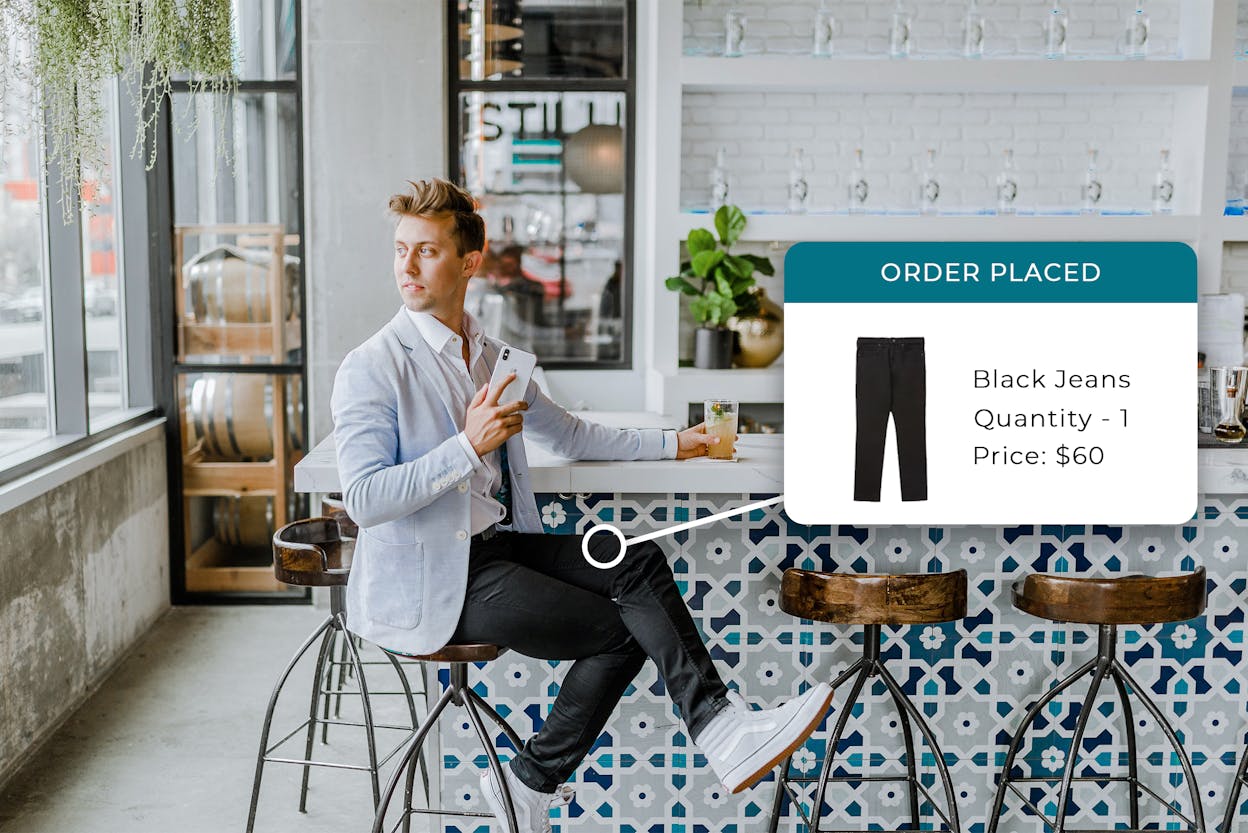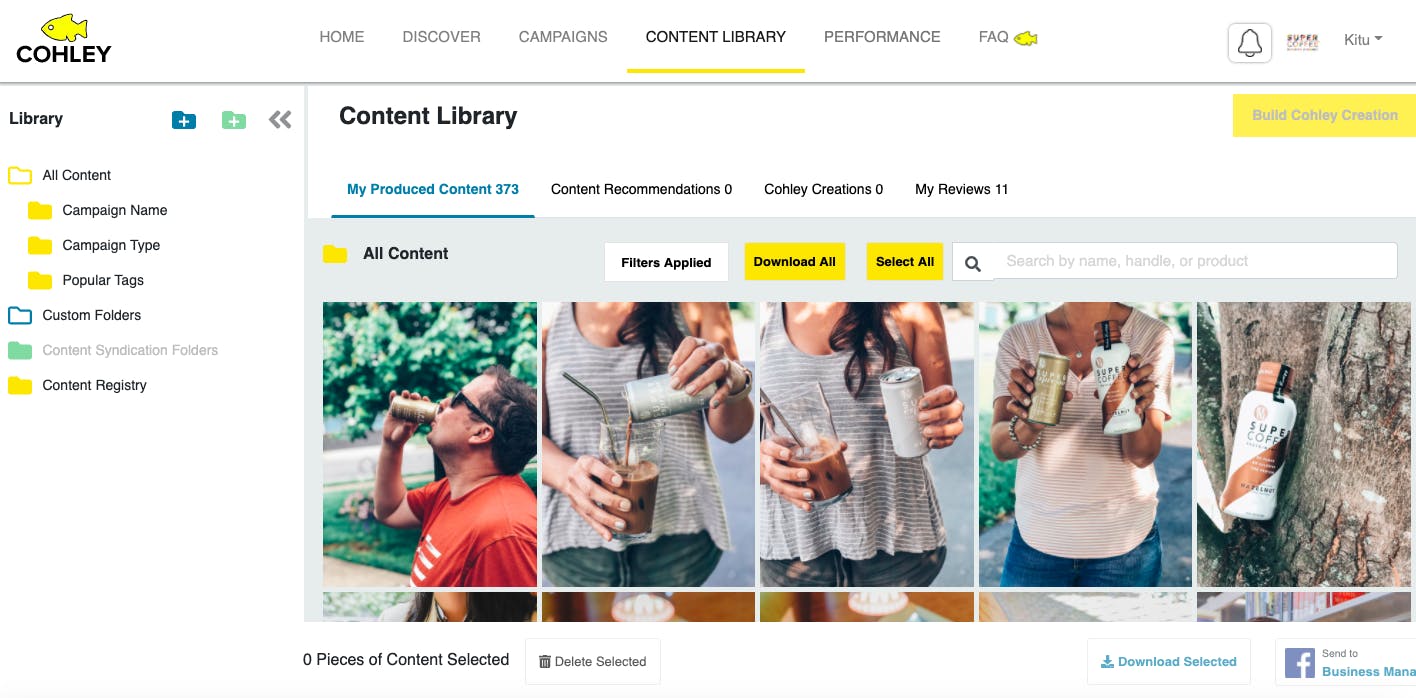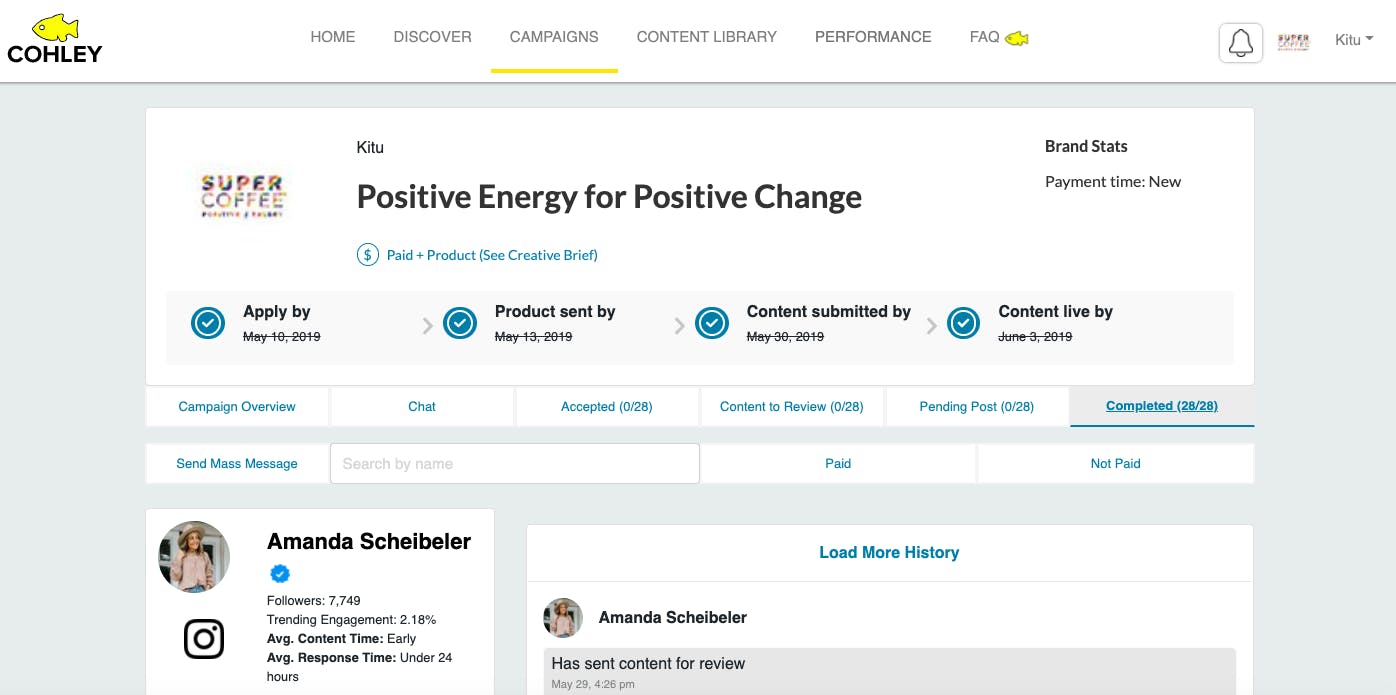11 Awesome Content Creation Tips for E-commerce with Cohley

Image source: Unsplash
Content creation for your e-commerce brand can feel like a daunting task. Constantly creating new images and videos is a lot to handle for a growing business.
However, creating authentic, thumb-stopping content is crucial to any merchant’s e-commerce content strategy.
One way to do this is with user-generated content (UGC). UGC is content in the form of images, video, text, and reviews that get created by people instead of by brands.
According to these stats that Hubspot pulled, 79% of people say UGC highly impacts their purchasing decisions. And, on average, 20% of consumers have unfollowed a brand on social media because they felt their content was inauthentic.
While UGC is most commonly seen on Instagram, you can also share it on your website, via email marketing, and other marketing channels.
You can manually search Instagram for content creators and then reach out on an individual basis. Or you can make your life easier and use a platform like Cohley — a platform that helps brands scale their content strategy in a way that’s both time and cost-efficient.
We chat with Tom Logan, Co-founder and CEO at Cohely about the importance of content creation for e-commerce and 11 content creation tips.
Let’s dive in.
MONEI (M): What’s the importance of content creation for e-commerce businesses?
Tom Logan (TL): Brands need more content now than they’ve needed at any other point in history. Between developing channel-specific strategies, to consumer personalization, to driving effective ad testing programs, content is really the lifeblood of an e-commerce business.
M: How can content help build brand loyalty?
TL: Well, a great product and/or consumer experience is obviously still critical to loyalty. On the content front, content that’s authentic goes a long way towards helping brands build lasting relationships with consumers.
Today’s consumers, particularly those that fall into the Millennial and Gen-Z categories, really do care a ton about what brands stand for. Are they diverse? Inclusive? Are they using a one-size-fits-all model and hoping to go a mile wide and an inch deep? Or are they taking the time to segment their target audiences and communicating with consumers? All of these things matter.
M: How can content impact e-commerce conversion rates?
TL: There are a number of stats that demonstrate the impact that having user-generated content right at the point of purchase can have. When my co-founder Erik and I were working at Piqora (acquired by Olapic), we would see conversion rates spike by anywhere from 1 - 4% on pages with adequate (4+) photos on the page. That might not seem like much, but think about the impact of that when you hit $50M a year? It’s huge!
11 Awesome Content Creation Tips
1. M: What are the different types of content that e-commerce businesses can focus on creating?
TL: Whew, there are a number of different types! It depends on how granular you’d like to get (i.e. “video content” or “Vertical shot UGC unboxing video”). In general, we break it down by photos, videos, and product reviews. All three are critical for different reasons.

2. M: What do you consider the top 5 best practices for generating content?
TL:
- You need to think about content on a channel-specific level! The same content that’s worked for you on Instagram, for example, isn’t guaranteed to work on TikTok.
- You need more content than you think you do.
- Think ahead! If you’re launching a new spring line on April 1st, how do you ensure that both your content library and e-commerce SKUs are optimized for performance starting on day one?
- Push yourself beyond your comfort zone, test, and measure content that you previously wouldn’t have considered using.
- Don’t serve 50-year-old and 25-year-old men the same content. Personalize your content and your overall messaging!
3. M: Why is it important to work with content creators versus doing it all on your own?
TL: Ah, such a great question! It’s all about content diversification. A photoshoot that costs $30k, for example, might yield 30 usable assets. The issue is, while those images might look good on a website, they don’t provide marketers with the assets they need to address their cross-channel content needs.
Even an in-house photographer, no matter how good they are, is limited to her/his immediate surroundings. For a growing brand, trying to put band-aids on their overall content needs just isn’t the right approach.
4. M: What are your top tips for working with influencers to create UGC?
TL: Don’t make them post on their own channels. Requiring a post in a collaboration means the influencer is essentially bound to the aesthetic of their feed. And the personal “brand” that they’ve cultivated for themselves. By removing this requirement, you’ll immediately notice that creators' adherence to your creative brief improves.
Further reading: Top 4 Tips to Succeed at Influencer Marketing for E-commerce
5. M: How can e-commerce merchants use data to inform their content strategy?
TL: You can increase the frequency and volume by which you test content. Learn from those tests, and incorporate those learnings into your next set of ads. We call this process “Content Engineering,” and it’s essentially applying the scientific method to content testing. Generate the content → Activate it across channels → Measure results → Inform future ad campaigns.
Content engineering is how every brand will approach content in 10 years. We firmly believe that not one content decision will be made without being heavily informed by data.

6. M: What marketing channels do you suggest e-commerce businesses start with to activate and test content?
TL: Facebook and Instagram CPMs (cost per thousand) are expensive, but if you can develop a semi-sophisticated testing process it’s worth it. Email marketing, of course, is still a major staple for e-commerce brands. Lots of our clients are also excited about the potential of SMS marketing.
7. M: What is the best way to measure content results?
TL: It depends on the channel! If you’re testing different assets on your e-commerce site, for example, you’ll be studying the variance in conversion rates. If you’re testing content in email, you’ll be primarily measuring click-through-rates.
8. M: What MarTech and CMS can e-commerce merchants consider using when creating their content strategy?
TL: We love working with brands on Shopify Plus and BigCommerce. The Shopify app store gets better every day, and BigCommerce has a ton of mid-market/enterprise level functionality that our clients rave about. An email marketing partner is next up, I’m biased, but we love our partnership and corresponding integration with Klaviyo. SMS is an exciting new channel that a number of our clients have seen a lot of success with, and we have an awesome integration with Attentive in the works. I’d be remiss if I didn’t mention Cohley here, too!
9. M: How often should e-commerce brands create and publish new content?
TL: In ads? Launch new tests every week. Find your “winners” and challenge them with fresh assets to stay well ahead of ad fatigue. Your native social strategy should be well-thought-out as well. Develop channel-specific posting strategies and learn from the data.
Content engineering is an “always on” methodology that involves a constant state of testing and refinement.
10. M: What are your top tips for generating product review content?
TL: Work with us! 70% of consumers consult reviews prior to making a purchase, and with stats like that, they’re a total non-negotiable. One thing to keep in mind is that you’ll want to do everything in your power to have product reviews already living on the product page from the day you launch. We can help!
11. M: Where can e-commerce merchants look for content trends?
TL: Start by identifying who the innovators and brand leaders are in your space. Follow their moves on Facebook, TikTok, YouTube, subscribe to their emails, etc. Process and learn!
M: Since starting Cohley in 2016, how have you seen the world of content creation and marketing evolve? And where is it headed in the future?
TL: Brands of all shapes and sizes are MUCH more open to incorporating third-party content into their overall marketing strategy. The term “UGC” has also evolved from being synonymous with grainy iPhone photos to anything created externally.
This is also worth noting, we’ve massively benefited from the continued advancements in smartphone camera technology. Individuals with a phone and an ounce of creativity can create content that’s hugely valuable for digital-first e-commerce brands, and that’s a huge advancement!
M: Anything else you’d like to add?
TL: Test, test, and test some more!
Moving Forward with Content Creation for Your E-commerce Business
A great content strategy starts with knowing your customers, knowing which channels they’re on, and creating a solid plan.
You can create a content calendar for a birds-eye view of your content plan for the next 3 - 6 months or even one year. It's up to you to decide how many campaigns you'd like to publish each month. Then you can get more detailed on precisely the content you need for each.
Whether it's images, video, text, or reviews — getting ahead helps you deliver an authentic and engaging experience for your existing and prospective customers.
You may also enjoy reading:
- 11 E-commerce Checkout Page Tips with Pineapple Development
- SMS Marketing Best Practices with E-commerce Growth Strategist Erin Lopez
- 15 E-commerce Conversion Rate Tips to Help You Sell More

Alexis Damen
Alexis Damen is a former Shopify merchant turned content marketer. Here, she breaks down complex topics about payments, e-commerce, and retail to help you succeed (with MONEI as your payments partner, of course).

